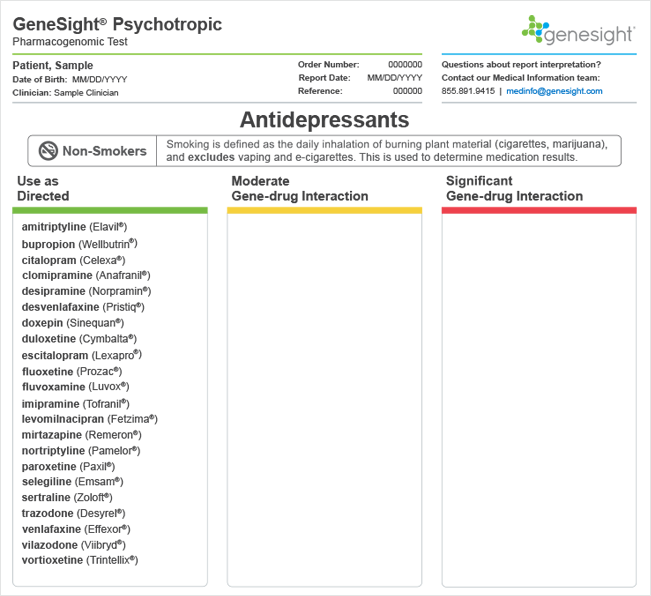GeneSight test results showing all medications in the green category still provides very useful information for you and your doctor. Here’s what an “all-green” report can mean.
The GeneSight® report is color coded with green, yellow and red categories to help classify how an individual patient may respond to a medication based on their unique genetic profile. Patients usually receive results that have medications listed in each of the three categories:
- Green means these medications are not associated with any known genetic issues that would be expected to change a patient’s medication response.
- Yellow means there is a moderate gene-drug interaction. This means these medications may require dose adjustments in order to have the desired effect or they may be less likely to work.
- Red means there is a significant gene-drug interaction. This means these medications are likely to require dose adjustments in order to have the desired effect, may be less likely to work, or may cause side effects.
A typical report has medications that fall in each of the three categories. However, in rare circumstances (about 0.7% of the time for GeneSight Psychotropic), a patient may receive an all-green report. This means there is no variation found in the patient’s genes that should impact their response to those medications.
What does it mean to have an all-green report?
Although the green category indicates that a medication may be used as directed, a patient may not always respond to medications that fall in the green category.
Other than the genes included on the GeneSight test, there are many things that can influence how your body responds to certain medications and whether you could experience side effects. These include drug-drug interactions, diet, social factors, psychological factors, environmental factors, age or gender.
However, our studies have found that patients using medications in the GeneSight test’s green category are significantly more likely to respond than patients prescribed medications in their red category.1–5
What does all-green report tell my doctor?
An all-green report provides important clinical information for your doctor to help manage your condition.
It can help “rule out” a genetic problem as the reason you may be failing to respond or are experiencing adverse effects to medications used to treat depression, anxiety, ADHD and other psychiatric conditions. As a result, your healthcare provider may research other reasons a medication isn’t having its desired effect (like a drug-food interaction, drug-drug interactions, other diseases you may have, or something else).
For some patients, this can lead to alternate approaches to treatment. For example, one published case study describes a patient who reported experiencing side effects from several antidepressants. Most medications on this patient’s report were in the green category, and genetic variation could not explain the patient’s acute sensitivity to various medications. After reading the results of the GeneSight test, the healthcare provider evaluated the psychological aspects of the patient’s sensitivity and decided on an alternative therapy for treatment.6
If you haven’t found a medication that works for you and you received an all green report, you may want to talk to your doctor about alternative treatments such as psychotherapy or others.
Questions?
For more information on how the GeneSight test can help you and your physician, visit GeneSight.com, email us at medinfo@assurexhealth.com, or phone 855.891.9415.
References
- Winner, J. G., Carhart, J. M., Altar, C. A., Allen, J. D., & Dechairo, B. M. (2013). A prospective, randomized, double-blind study assessing the clinical impact of integrated pharmacogenomic testing for major depressive disorder. Discovery Medicine, 16(89), 219–27. Retrieved from https://www. ncbi.nlm.nih.gov/pubmed/24229738
- Hall-Flavin, D. K., Winner, J. G., Allen, J. D., Jordan, J. J., Nesheim, R. S., Snyder, K. A, Mrazek, D.A. (2012). Using a pharmacogenomic algorithm to guide the treatment of depression. Translational Psychiatry, 2(March), e172. doi:10.1038/tp.2012.99
- Hall-Flavin, D. K., Winner, J. G., Allen, J. D., Carhart, J. M., Proctor, B., Snyder, K. a, … Mrazek, D. a. (2013). Utility of integrated pharmacogenomic testing to support the treatment of major depressive disorder in a psychiatric outpatient setting. Pharmacogenetics and Genomics, 23(10), 535–48. doi:10.1097/FPC.0b013e3283649b9a
- Winner, J., Allen, J. D., Anthony Altar, C., & Spahic-Mihajlovic, a. (2013). Psychiatric pharmacogenomics predicts health resource utilization of outpatients with anxiety and depression. Translational Psychiatry, 3(3), e242. doi:10.1038/tp.2013.2
- Altar CA, Allen JD. Clinical Utility of Combinatorial Pharmacogenomics-Guided Antidepressant Therapy : Evidence from Three Clinical Studies. 2015:1-11. doi:10.1159/000430915.
- Winner JG, Allen JD, Lorenz JP, Altar CA. Overwhelmed by side effects. Curr Psychiatr. 2012;11(6).


